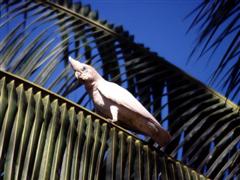Corella - Little
Scientific Name: Cacatua pastinator sanguinea
Mon, 30th June, 2025 - 9:37 pm GMT
Sponsor Ads:

Alternative Name
Scientific Name: Cacatua pastinator sanguineaBasic Info
With grayish white feathers and curved, short white beaks, Little Corellas are attractive birds. Their periopthalmic rings are blue-gray, and they have pale red coloration about their beaks. Their feathers occasionally have a pinkish orange tinge to their bases, which is especially evident about the bird?s lores. The only difference between the Little Corella sexes is in the size of the body or head, though often it is still very difficult to tell and DNA sexing is required.
Health
Specific Care Information: Relative Care Ease: Average Little Corellas often pluck their feathers, so be sure to provide lots of toys and branches for them to chew on, fending off boredom. Because they spend so much time on the ground, Little Corellas are prone to intestinal worms and fungal infections. The majority of these can be prevented by proper hygiene. Psittacine Beak and Feather Disease is another common problem and is incurable. Birds with the disease have black feathers and fragile beaks, which do not heal. The disease is transmitted through feces, and infected birds must be put down. Breeding In the wild, the majority of Little Corellas breed between June and October, though there is no specific breeding season. In captivity, Little Corellas will need a nesting log of about a meter in length with a 35 centimeter internal diameter. It may be placed vertically or at a slant, and you should provide peat moss, dirt and wood shavings as nesting material. Make about a six to eight inch layer of nesting, as many Little Corellas will like to excavate their nests somewhat. Although Little Corellas have bred at earlier ages, they usually mate for the first time at four or five years and many pairs will not clutch until they are six or seven. A clutch consists of one to three eggs, which incubate for approximately 26 days. The young fledge at around 56 days of age.Habitat
N/ABehavior
With pristine appearances and lovely personalities, the Little Corella makes a wonderful pet and a good friend. The Little Corella generally has a good attitude and can be taught to talk and do tricks. These lovely birds welcome your attention and affection, but be careful; as with many parrots they are escape artists. Little Corellas love to chew and can often bite their way out of wire cages. They like open grassland or open forest and are usually found near water. Little Corellas are very vocal in the wild and do not have a set home range; rather, they are nomadic. In captivity, your Little Corella needs fresh water at all times. They do very well when kept in pairs. A single bird will do fine in a cage of at least 800 by 600 by 1200 millimeters in dimension. Little Corellas will thrive, however, in large aviaries with steel frames and very heavy wire. These should be about two by two by six meters in dimension. In the wild, Little Corellas build their nests in holes of tall trees or hollow branches and line them with soft wood shavings. The courtship display of Little Corellas is typical of Cockatoos; the male bobs his head and screeches at his intended female while spreading his wings and tail and holding his crest high. Little Corellas intending to breed will pay a great deal of attention to their nesting site, loitering around the entrance and inside, and chewing on the entrance.Origin
AustraliaHistory
Little Corellas are native to Australia and the surrounding islands. There are a number of subspecies of this bird both in the wild and in captivity. They have long been valued as sweet, friendly pets. Little Corellas have been crossed with Galahs, Major Mitchell Cockatoos, Gang Gang Cockatoos and Sulphur-crested Cockatoos.Common Foods
In the wild, Little Corellas eat seeds, insects, bulbs and fruit.Sponsor Ads:
It could probably be shown be facts and figures that there is no distinctively native American criminal class -- except Congress. --Mark Twain
Corella - Little
Coded by: BGID® | ALL RIGHTS RESERVED Copyright © 2000-2025
Disclaimer | Privacy | Report Errors / Contact | Credits








 Why haven't we as a collective earth met with aliens yet?
Why haven't we as a collective earth met with aliens yet?  World EcoSystem - Biodiversity Changes - Who is on board and who isn
World EcoSystem - Biodiversity Changes - Who is on board and who isn  Homosexual behavior stems from the mind or genetics?
Homosexual behavior stems from the mind or genetics?  The Best Text Adventure You Will Ever Play! The official site:
The Best Text Adventure You Will Ever Play! The official site:  Mouthwash - Mouthrinse - Mouth Sores - Healing Infections - Gingivitis
Mouthwash - Mouthrinse - Mouth Sores - Healing Infections - Gingivitis  Treatment for Depression
Treatment for Depression  Ultra radical and violent Islamist group that even rivals Al Qaeda
Ultra radical and violent Islamist group that even rivals Al Qaeda  An idea to have teachers who want to carry guns to school undergo some level of police training will be left up to local school districts and police departments.
An idea to have teachers who want to carry guns to school undergo some level of police training will be left up to local school districts and police departments.